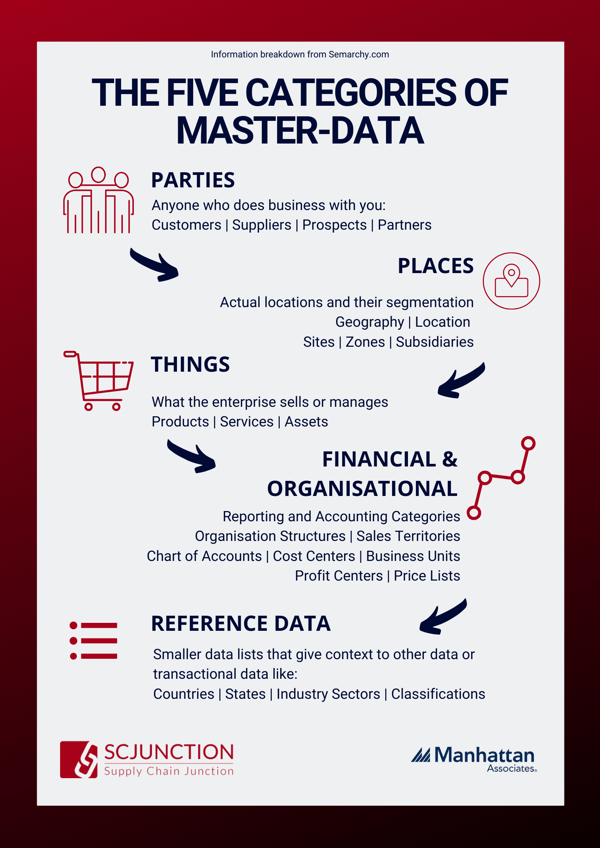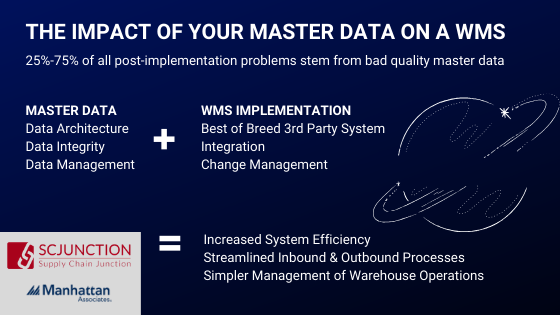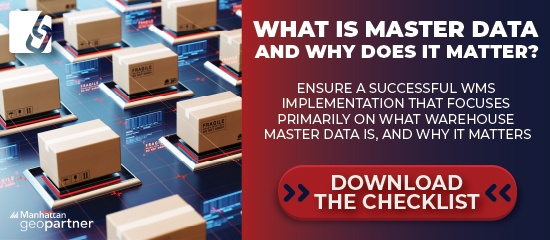Master Data Masterclass: Don’t let “Our data is GREAT!” be your famous last words.


With a larger reliance on data than ever before, the warehouse management, distribution, and supply chain industries need to start brushing up on their data management skills.
When we are called into businesses to implement an integrated Warehouse Management System, we stress the importance of the existing master data to our clients. Often, we hear “we have GREAT master data!”, only to find that “GREAT” is entirely subjective, and the data provided is sub-par or incomplete, causing performance issues after implementation.
Doron Neuhaus, a Project Manager for Supply Chain Junction, stresses that this gap in understanding of what “GREAT!” master data actually is and how it can impact your WMS effectiveness down the line is not caused by generally shoddy data management (compared to your competitors), but by a technological immaturity throughout the distribution industry.
Because the impetus to improve master data management and integrity isn’t driven by protection of personal information, or privacy-sensitive material (as it is in the banking and finance, health, and retail industries), it has been somewhat left behind in the distribution and supply-chain structures that are now evolving with new management technologies.
While your WMS vendor may be able to guide you in the management, architecture, and integrity of your data, the implementation period of roughly 6-8 months for a WMS is not enough time for us to get familiar with your entire product set, your data requirements, and your particular requirements of your master data.
To make the process easier, we’re giving you the Master Data masterclass in this blog, with access to our tools and resources, so that your master data can perform (more) perfectly with a best-in-class Warehouse Management System.
What is Master Data in your business?

Within your business structure are the five categories of master data:
1. Parties
Your supplies, partners, prospects, and customers – the people who provide you with data, the data you store, and the data you send in order to communicate, receive and ship your products.
2. Places
Each location that is relevant to your business – including all business-related sites like warehouses, offices, and distribution centres, and your supplier sites, delivery sites, and shipping addresses. This is a huge subset of data to manage and maintain.
3. Things
Your products, services, and assets that must either be received, stored, and shipped, or maintained for optimal performance within your business and warehouse.
4. Finance & Organisational
The structure of your organisation must be broken down into data subsets, which allows you to divide up the data required to efficiently run your business into reporting and accounting, sales data, accounts and customer data, cost centre data, business units, profit centres, and pricing data. This is another massive subset that requires constant care and management to aid the efficiency of your business.
5. Reference Data
Your reference data is the information that supports all your major data subsets, like pricing, customer behaviour, supply and demand, and sector-specific performance and reporting. It’s critical to ensure that this data is correct, so that it feeds accurate information into your larger, more commonly accessed data pools.
All of these categories of information impact how well your WMS (or, indeed, any solution you are adding to your software stable) can perform its designated tasks.

Before you continue with the steps required to MAINTAIN your master data, it’s critical to analyse whether your current data as outlined above is completely accurate, available, accessible to other applications (and your personnel) and properly stored within your data architecture and management structure.
How to match your Master Data to architecture, management, and integrity best-practices
First, establish the objectives you need to fulfill with the implementation of your WMS (or any other software within your business):
- Improved efficiency
- Productivity
- Reduction in costs in specific sectors
- Improved profitability
- Higher customer retention
The above lists just a few of the big-picture outcomes that businesses are looking for in their new software systems implementations.
How does your existing data management and quality help you to achieve these things?
If it doesn’t, consider where and how you will need to supplement your data architecture and management personnel to ensure you can meet these requirements.
Three personnel considerations to move forward with a high-integrity master data strategy:
1. Ownership & responsibility
Your master data strategy should focus on the addition of an ownership and responsibility structure for your data. This means that your usual IT guy just won’t cut it – and he’ll probably breathe a sigh of relief to have a dedicated team to assist in the maintenance and management of your very extensive data.
2. Commitment to maintenance of centralised data sources
Your centralised data sources which interface with new technologies and are integrated into your existing ERPs and other systems must be maintained and curated in order to ensure an ongoing quality of information throughout your software systems, with a single unified version of information that is available to all arms of your business. This removes the errors, miscommunications, and stumbling blocks which pepper the implementation of new technologies.
3. Technical maturity
Your business will need to change its outlook to provide the technical requirements for your data management. This is an important undertaking because regardless of your various divisions and departmental requirements, the entire business needs to be on board with the updates and structural changes that will follow the commitment to high-integrity, well-managed data in a practical, functional architecture.
Making changes in your approach to data needs the support of a change-management strategy
… and a change-management with a strategy to sell the changes in systems, processes, and culture to the workforce, getting employee buy-in early on.
Here’s what you should be looking for in the team who will drive the change within your business, and help to streamline your changeover from dodgy data to best-in-class:
- Understand the requirements and capabilities of your potential WMS
- Able to establish the impact per department
- Will assess the company-wide impacts and plan for the change
- Ease the transition with communication, training, and transition plans.
See the full change-management breakdown for a smoother, simpler transition to technical maturity in your warehouse, business, and industry.
Benchmarking for master data integrity outside your industry
Benchmarking against your key industry competitors is a great idea for performance, customer engagement, and trends, but in order to truly get your master data performance-ready, you need to look at the real technology leaders in any industry and take notes from their best practices.
Look to the medical aid or medical insurance providers, the banks, and the asset managers for the data management holy grail – you will see that the industry leaders all have these things on common:
What business leaders can teach you about Master Data:
1. Outline your business goals
Ensure your data management strategy will support you, whether you aim to improve your bottom line, beef up decision making, or more accurately cater to consumer trends.
2. Prioritise your data protection and security
Treat your data with the reverence of banks, insurance companies, and medical service providers. In the short-term, it will give you secure, accurate information. In the long run, it will ensure that any growth, expansion, or change to your services keeps the information secure and stored according to regulations, whatever you intend to use it for.
3. Focus on the quality of your data
Use only what is accurate and relevant to your business. Superfluous data may be good to have, or “nice to know”, but if it serves no real purpose, it’s taking up valuable space, processing power, and time that should be focused on the data that impacts your business. If you need to check this, use the data categories outlined at the start of this blog.
4. Keep it clean
Remove duplications, standardise the data capturing process and syntax, train your staff on the correct data-capturing procedures, and check the data regularly for accuracy and reliability.
5. Keep data accessible
This relies heavily on your data architecture, and the structures put in place by your data management team. Permissions and access will vary based on roles, and you need to stay on top of this to prevent sabotage, human error, inappropriate client contact, and uninformed changes to your master data. The teams who need it should have full access, and protected information must be kept that way.
6. Create a data recovery strategy
While having your data stored within secure servers or cloud applications may be a comforting thought, anything can happen to compromise those structures. Consider how you will back-up, restore, and recover your data if the worst happens.
7. Get a best-of-breed data management solution
A good data suite is one that can integrate and interface with your software solutions and give you the tools you need to satisfy your master data requirements.
It’s a lot of work to get your data to stand up against international best practices, but the more robust, accurate and structured your approach to master data management and its integrity, the higher your chances of success will be.
In addition, if you focus on master data, you can unlock more functionality from your WMS in the short-, medium-, and long-term, since so many core configurations reliant on the availability and quality of your master data.
Check out our Master Data Checklist to ensure a successful WMS implementation that focuses primarily on what warehouse master data is, and why it matters
TAGS
- WMS (51)
- Warehouse Best Practice (46)
- Implementing a WMS (29)
- Managing your warehouse (19)
- Omni Channel (18)
- eCommerce (18)
- Blog (16)
- Supply Chain Best Practice (16)
- Customer Journey (9)
- Mid-Level (8)
- Warehouse optimisation (7)
- General Tips (5)
- Industry General (5)
- Information (5)
- Trends (5)
- managing your Supply Chain (5)
- saudi arabia (5)
- Press Release (4)
- smart warehouse (4)
- 3PL (3)
- News (3)
- ERP (2)
- Entry-level (2)
- ROI (2)
- Case Study (1)
- OMS (1)
- Picking (1)
- Solution-Specific (1)
- Transport Management System (1)
Take A Look At The Results Of A Successful WMS Implementation.
See how Tarsus Distribution, in collaboration with SCJ boost overall efficiency by 60%





